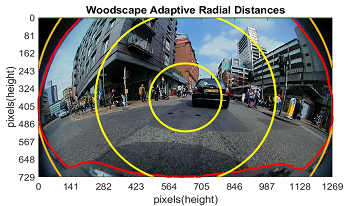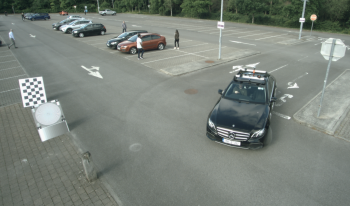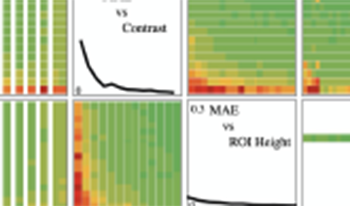
The Modulation Transfer Function (MTF) is an important image quality metric typically used in the automotive domain. However, despite the fact that optical quality has an impact on the performance of computer vision in vehicle automation, for many public datasets, this metric is unknown. Additionally, wide field-of-view (FOV) cameras have become increasingly popular, particularly for low-speed vehicle automation applications. To investigate image quality in datasets, this paper proposes an adaptation of the Natural Scenes Spatial Frequency Response (NS-SFR) algorithm to suit cameras with a wide field-of-view.

This paper investigates the relationship between image quality and computer vision performance. Two image quality metrics, as defined in the IEEE P2020 draft Standard for Image quality in automotive systems, are used to determine the impact of image quality on object detection. The IQ metrics used are (i) Modulation Transfer function (MTF), the most commonly utilized metric for measuring the sharpness of a camera; and (ii) Modulation and Contrast Transfer Accuracy (CTA), a newly defined, state-of-the-art metric for measuring image contrast. The results show that the MTF and CTA of an optical system are impacted by ISP tuning. Some correlation is shown to exist between MTF and object detection (OD) performance. A trend of improved AP5095 as MTF50 increases is observed in some models. Scenes with similar CTA scores can have widely varying object detection performance. For this reason, CTA is shown to be limited in its ability to predict object detection performance. Gaussian noise and edge enhancement produce similar CTA scores but different AP5095 scores. The results suggest MTF is a better predictor of ML performance than CTA.

Recent research on digital camera performance evaluation introduced the Natural Scene Spatial Frequency Response (NS-SFR) framework, shown to provide a comparable measure to the ISO12233 edge SFR (e-SFR) but derived outside laboratory conditions. The framework extracts step-edges captured from pictorial natural scenes to evaluate the camera SFR. It is in 2-parts. The first utilizes the ISO12233 slanted-edge algorithm to produce an ‘envelope’ of NS-SFRs. The second estimates the system e-SFR from this NS-SFR data. One drawback of this proposed methodology has been the computation time. The process was not optimized, as it first derived NS-SFRs from all suitable step-edges and then further validated and statistically treated the results to estimate the e-SFR. This paper presents changes to the framework processes, aiming to optimize the computation time so that it is practical for real-world implementation. The developments include an improved framework structure, a pixel-stretching filter alternative, and the capability to utilize Graphics Processing Unit (GPU) acceleration. In addition, the methodology was updated to utilize the latest e-SFR algorithm implementation. The resulting code has been incorporated into a self-executable user interface prototype, available in GitHub. Future goals include making it an open-access, cloud-based solution to be used by scientists, camera evaluation labs and the general public.

The edge-based Spatial Frequency Response (e-SFR) is an established measure for camera system quality performance, traditionally measured under laboratory conditions. With the increasing use of Deep Neural Networks (DNNs) in autonomous vision systems, the input signal quality becomes crucial for optimal operation. This paper proposes a method to estimate the system e-SFR from pictorial natural scene derived SFRs (NSSFRs) as previously presented, laying the foundation for adapting the traditional method to a real-time measure.In this study, the NS-SFR input parameter variations are first investigated to establish suitable ranges that give a stable estimate. Using the NS-SFR framework with the established parameter ranges, the system e-SFR, as per ISO 12233, is estimated. Initial validation of results is obtained from implementing the measuring framework with images from a linear and a non-linear camera system. For the linear system, results closely approximate the ISO 12233 e-SFR measurement. Non-linear system measurements exhibit scene-dependant characteristics expected from edge-based methods. The requirements to implement this method in real-time for autonomous systems are then discussed.

The Modulation Transfer Function (MTF) is a wellestablished measure of camera system performance, commonly employed to characterize optical and image capture systems. It is a measure based on Linear System Theory; thus, its use relies on the assumption that the system is linear and stationary. This is not the case with modern-day camera systems that incorporate non-linear image signal processes (ISP) to improve the output image. Nonlinearities result in variations in camera system performance, which are dependent upon the specific input signals. This paper discusses the development of a novel framework, designed to acquire MTFs directly from images of natural complex scenes, thus making the use of traditional test charts with set patterns redundant. The framework is based on extraction, characterization and classification of edges found within images of natural scenes. Scene derived performance measures aim to characterize non-linear image processes incorporated in modern cameras more faithfully. Further, they can produce ‘live’ performance measures, acquired directly from camera feeds.

We discuss several common image quality measurements that are often misinterpreted, so that bad images are falsely interpreted as good, and we describe how to obtain valid measurements. Sharpness, which is measured by MTF (Modulation Transfer Function) curves, is frequently summarized by MTF50 (the spatial frequency where MTF falls to half its low frequency value) But because MTF50 strongly rewards excessive sharpening, we recommend other summary metrics, especially MTF50P (the spatial frequency where MTF falls to half its peak value), that provide a more stable indication of system performance. Camera dynamic range (DR), defined as the range of exposure (scene brightness) where the image has good contrast and Signalto- Noise Ratio (SNR), Is usually measured with grayscale step charts. We have recently seen several cases where flare light radiating out from bright areas of the image fogs dense patches, causing unreasonably high DR measurements. This situation is difficult to handle with linear test charts, where the flare light is aligned with the patches, but can be handled well in charts with circular patch patterns, where the patch where pixel level ceases to decrease defines the upper DR limit.

Objective measurements of imaging system sharpness (Modulation Transfer Function; MTF) are typically derived from test chart images. It is generally assumed that if testing recommendations are followed, test chart sharpness (which we also call “chart quality”) will have little impact on overall measurements. Standards such as ISO 12233 [1] ignore test chart sharpness. Situations where this assumption is not valid are becoming increasingly frequent, in part because extremely high-resolution cameras (over 30 megapixels) are becoming more common and in part because manufacturing test stations, which have limited space, often use charts that are smaller than optimum. Inconsistent MTF measurements caused by limited chart sharpness can be problematic in manufacturing supply chains that require consistency in measurements taken at different locations. We describe how to measure test chart sharpness, fit the measurement to a model, quantify the effects of chart sharpness on camera system MTF measurements, then compensate for these effects using deconvolution–by dividing measured system MTF by a model of the chart MTF projected on the image sensor. We use results of measurements with and without MTF compensation to develop a set of empirical guidelines to determine when chart quality is • good enough so that no compensation is needed, and • too low to be reliably compensated.

The modulation transfer function (MTF) describes how an imaging system modifies the spatial frequency content of a scene. Many performance metrics and specification requirements are strongly dependent on the MTF as it provides information on the limiting resolution of the imaging system. In this correspondence we will identify potential issues that can contribute uncertainty or bias into the MTF measurement, and suggest best practices to avoid such issues. Beginning with a full 2D derivation of the tilted edge measurement technique, we identify potential areas where differences between laboratories can occur due to the setup, imaging system, measurement procedure, or the measurement processing. We show specific examples of how the system’s nonuniformity (including defective pixels) can affect the observed MTF. Additionally, we show examples of target to target variation and the effects of dynamic range. A summary table is provided on best practices to reduce the impact of the identified potential areas of difference. In support of the reproducible research effort, the Matlab functions associated with this work can be found on the Mathworks file exchange [1].

Training autonomous vehicles requires lots of driving sequences in all situations[1]. Typically a simulation environment (software-in-the-loop, SiL) accompanies real-world test drives to systematically vary environmental parameters. A missing piece in the optical model of those SiL simulations is the sharpness, given in linear system theory by the point-spread function (PSF) of the optical system. We present a novel numerical model for the PSF of an optical system that can efficiently model both experimental measurements and lens design simulations of the PSF. The numerical basis for this model is a non-linear regression of the PSF with an artificial neural network (ANN). The novelty lies in the portability and the parameterization of this model, which allows to apply this model in basically any conceivable optical simulation scenario, e.g. inserting a measured lens into a computer game to train autonomous vehicles. We present a lens measurement series, yielding a numerical function for the PSF that depends only on the parameters defocus, field and azimuth. By convolving existing images and videos with this PSF model we apply the measured lens as a transfer function, therefore generating an image as if it were seen with the measured lens itself. Applications of this method are in any optical scenario, but we focus on the context of autonomous driving, where quality of the detection algorithms depends directly on the optical quality of the used camera system. With the parameterization of the optical model we present a method to validate the functional and safety limits of camera-based ADAS based on the real, measured lens actually used in the product.